
This is a list of the National Register of Historic Places listings in Erie County, Ohio.

The Armstrong Farm, also known as the Reber Farm, is a historic farm complex near Upper Sandusky in Crane Township, Wyandot County, Ohio, United States. Known for its association with Thomas V. Reber, a longtime president of the Wyandot County Agricultural Society, it was built in 1830.

Bagby–Hossler House is a historic house in Tiffin, Ohio.

The former Odd Fellows Hall, located at 231 West Washington Row in Sandusky, Ohio, in the United States, is an historic building built in 1889 by members of the Independent Order of Odd Fellows. It is also known as the Independent Order of Odd Fellows Temple. On May 1, 2003, it was added to the National Register of Historic Places.

The Spacecraft Propulsion Research Facility, now known as the In-Space Propulsion Facility, is, the "world’s only facility capable of testing full-scale upper-stage launch vehicles and rocket engines under simulated high-altitude conditions." The facility, located at NASA's Plum Brook Station of the Glenn Research Center near Sandusky, Ohio, was built in 1968. Its first major use was for testing stages of the Centaur Rocket, which was used to launch some of America's most important space probes. The facility was designated a National Historic Landmark in 1985.
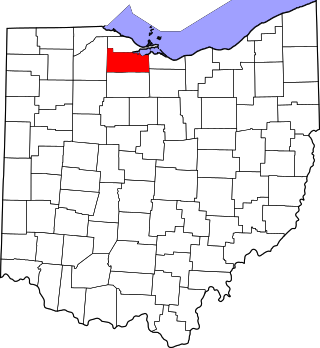
This is a list of the National Register of Historic Places listings in Sandusky County, Ohio.
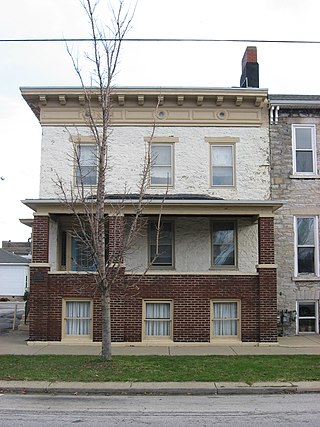
The Eleutheros Cooke House at 410 Columbus Avenue in Sandusky, Ohio is the oldest surviving house in Sandusky. It is a Greek Revival style house that was built in 1827 by Eleutheros Cooke, one of the first settlers in the area and its first lawyer. The original front porch of the house saw General William Henry Harrison receive a flag from the women of Sandusky, in 1835.

The Eleutheros Cooke House, also known as the Cooke-Dorn House, at 1415 Columbus Avenue in Sandusky, Ohio is a three-story, limestone Greek Revival style house that was built in 1844. It was the last home of Eleutheros Cooke, one of the first settlers in Sandusky and its first lawyer. Eleutheros was father of Jay Cooke, the Civil War financier.
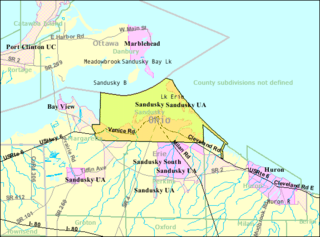
This is a list of the National Register of Historic Places listings in Sandusky, Ohio.

The Sandusky County Jail and Sheriff's House is a historic government building near downtown Fremont, Ohio, United States. Built in the early 1890s, it was used as an incarceration facility for almost a century before closing and being converted into an office building.

The Frederick Fabing House is a historic residence in Fremont, Ohio, United States. Built as the home of one of the area's richest men, it has been designated a historic site.

The Mull Covered Bridge is a historic wooden covered bridge in the northwestern portion of the U.S. state of Ohio. Built in the middle of the nineteenth century, it is located near Burgoon in Sandusky County. Although it is no longer used to facilitate transportation, the bridge has been preserved and is now a historic site.

George Feick was a German-American builder in Sandusky and Oberlin, Ohio. His works include the Wyoming State Capitol, multiple buildings at Oberlin College, and numerous office buildings, churches, schools, libraries and residences in and around Sandusky. Several of his works are listed on the National Register of Historic Places.

The John Stang House at 629 Columbus Ave. in Sandusky, Ohio was built in 1922 by George Feick. It was listed on the National Register of Historic Places in 1982.

The Taylor-Frohman House at 1315 Columbus Ave. in Sandusky, Ohio was built in 1906. It was built by George Feick. It includes Colonial Revival architecture. It was listed on the National Register of Historic Places in 1982.
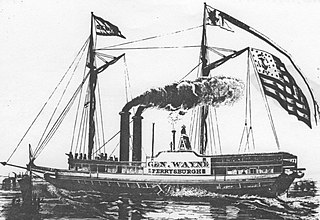
The PS Anthony Wayne was an early wooden-hulled sidewheel steamship that sank on April 28, 1850, in Lake Erie off the coast of Vermilion, Ohio, after two of her starboard side boilers exploded. The number of people on board the ship at the time of incident is estimated to be about 100. The ship's clerk reported that there were 80 to 100 people on board, which included the crew, with about 30 of them surviving.

The Central Ohio Fire Museum is a firefighting museum in Downtown Columbus, Ohio, housed in the former Engine House No. 16 of the Columbus Fire Department, built in 1908. It was listed on the Columbus Register of Historic Properties in 1983 and the National Register of Historic Places in 1995.

The Engine House No. 1 in Sandusky, Ohio was built in 1915. It was listed on the National Register of Historic Places in 1982.
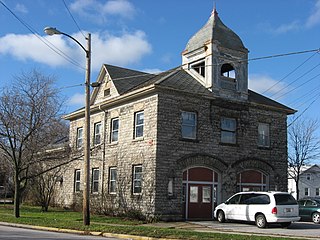
No. 5 Fire Station in Sandusky, Ohio, was built in 1906. It was listed on the National Register of Historic Places in 1982.

August Kuebeler House is a historic residence in Sandusky, Ohio. It has been listed on the National Register of Historic Places since 1982. The home is privately owned and not open to the public.




















